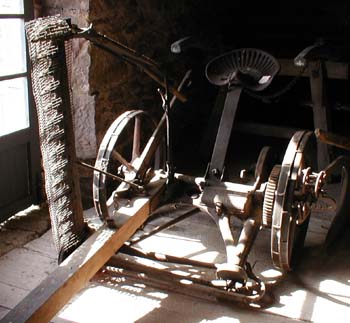Mowing grass with horses

David Trotter: "You would be up in a morning, say four o’clock, with a pair of horses, and mow, and then come home and milk, leave your mowing machine in the field sort of thing.
"You didn't mow a lot [at a time], well you didn't know how the weather was going to be, if you could get a lot - well, it used to take us a month to haytime. Same as today they'll mow the bloody lot won't they, and then they'll work it and they'll get it all, sort of in a week. If it was a small field then you'd mow it in one, but big fields, you just used to mow it in beds.
"There was one spot we mowed with a single horse: the mower had a Petter engine on, and that drove the cutter-bar, and the horse just had to pull it, but usually it took two horses, you know, they had to go at a fair old rake o' knots."
McCormick grass-mower for harvesting hay. The cutter bar is guarded here for safety. It was driven by the rotation of the wheel on the right of the picture.
"First spot I ever went at, you used to go down with your mowing machine, it would be sort of on the inside, your horse would go down the dyke-side (field boundary: hedge or wall), and you would mow this way round, lefthanded, happen about four times, and then somebody would come on, usually t'farm lad, and would rake that back, as they call it taking the backswathe back, and he would roll it against itself, over, so that you could come in with your horse, t'other way on, righthanded, and mow the rest. And then you'd to come with a ley (scythe) and mow right up to the dyke-side, so you got every bit of hay.
"Now the first time that we didn't do that was down at Alec Hornby's. Up till then, whenever I mowed, we took the backswathe out. Anyway, I was mowing, and I got the field finished, and I was going to do t'backswathe, and Alec's father said, "no, no, don't bother wi' that, no," he said, "we'll just put cows in," which is what they do now. But they take it younger now, you see; when we were mowing, you weren't taking it until sort of July or August, whereas they take it in April and May now don't they. When it goes for silage, it isn't that long, and cows go in afterwards and clean off round the edges. It used to be real long and tough, three foot high, you know, and then they wanted every bit of winter feed they could get off the field."